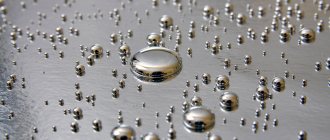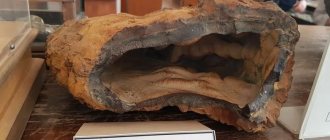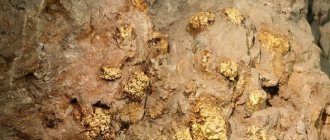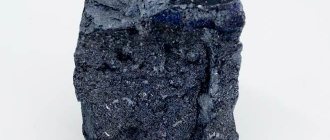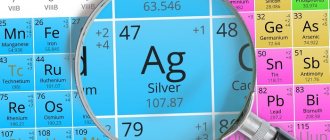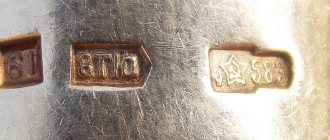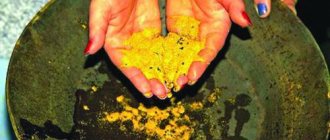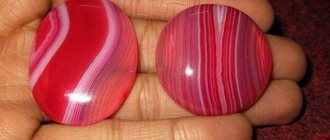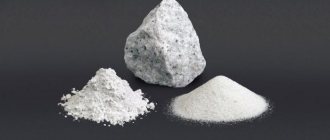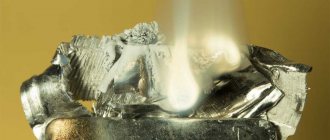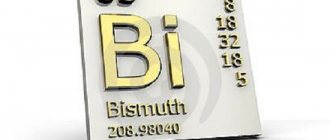In the Middle Ages, Europeans called Rus' Ruthenia. For them, these lands were the territory of “rebellious tribes”, “savages and pagans”, incomprehensible and unpredictable peoples.
Our current hero is named after Ruthenia very “on point”. Metal is still largely mysterious, unexplained and sometimes explosive - like Russia itself. So K. Klaus, who gave the name to the platinoid, hit the bull's eye.
Ruthenium is a very hard and refractory, but very brittle platinum group metal.
Ruthenium - properties of a noble metal
Ruthenia means "Russia" in Latin. Like Russia, ruthenium is beautiful, mysterious and extremely inconvenient for humans. Firstly, obtaining pure ruthenium is a problem that has not yet been solved.
Secondly, ruthenium is so fragile that it is not possible to use it in its pure form. Third, ruthenium, found in the form of various chemical compounds, is often dangerous.
Including explosive ones!
Why not Russia?
Who is guilty?
More recently, scientists in Western Europe seriously worried the public with a message that the content of the radioactive isotope of ruthenium Ru106 was growing over the continent. Experts completely exclude its self-education in the atmosphere. As well as an emergency release from a nuclear power plant, since then cesium and iodine radionuclides would necessarily be present in the air, which is not confirmed by experimental data. The impact of this isotope on the human body, like any radioactive element, leads to irradiation of tissues and organs and the development of cancer. Possible sources of pollution, according to Western media, are located in Russia, Ukraine or Kazakhstan.
In response, a representative of the Rosatom Communications Department stated that all enterprises of the state corporation were and are working as usual. The International Atomic Energy Agency (IAEA), in its conclusion, based on its own monitoring data, called all accusations against the Russian Federation groundless.
How metal was discovered
Ruthenium came into the sphere of interest of scientists in the mid-19th century, when platinum fever began in the Urals.
However, the story turned out to be complicated:
- In 1827, a German chemist and professor at the University of Dorpat, Gottfried Ozanne, completed a series of works on “unpacking” Ural ore. The presence of three metals unknown to science was discovered, which he named polyne, poluran, and ruthenium.
- The achievement did not resonate with colleagues: most considered it a mistake. And the resulting substance is poorly purified platinum iridium.
- Thirteen years later, Karl Klaus, an ethnic German who was born in Russia and became a professor at Kazan University, undertook to repeat Ozanne’s experiments. He was assisted by the Polish scientist Andrzej Sniadecki.
- Four years later (1844) they introduced about 6 grams of ruthenium. Thus, a new element was discovered and Ozanne’s results were confirmed.
- Scientists examined the physical and chemical properties, established the atomic mass, and the amount of ruthenium - 1.1%.
The metal is named after the country where it was first discovered. This is what the discoverer Gottfried Ozanne suggested. Russia took its place in the periodic table.
Ruthenia is a Latinized version of the toponym Russia. This is how the state was called Europe until the 15th century.
According to another version, the same Snyadetsky was the first to study this chemical element back in 1809. He named the new element vestia, after the asteroid Vesta, discovered two years earlier.
The Soviet scientist S.M. Starostin devoted his entire life to the study of metal.
"Discovery" by Ozanne
Professor of the Dorpat-Yuryev (now Tartu) University Gottfried Ozanne began studying the composition of the Ural precious ore. He came to the conclusion that platinum was accompanied by three unknown metals - poluran, polynomial and ruthenium - the names of which were given by Ozanne himself. By the way, he named the third one in honor of Russia (from the Latin Ruthenia).
Ozanne's colleagues throughout Europe, led by the most authoritative Swedish chemist Jens Berzelius, were very critical of the professor's message. In an attempt to justify himself, the scientist repeated a series of his experiments, but failed to achieve the same results.
Two decades later, chemistry professor Karl Karlovich Clauss (Kazan University) became interested in Ozanne’s work. He obtained permission from the Secretary of the Treasury to obtain several pounds of coin production residues from the Mint laboratory for re-examination.
Metal in nature
In terms of prevalence, ruthenium is perhaps the rarest of the noble metals: its share in the earth’s crust is 1x2-6%. Meteorites contain 200 times more substance.
The total mass of explored reserves of ruthenium is estimated at 5 thousand tons.
The mineral is found using the following markers:
- Bedrock deposits or placers of platinum-bearing rocks.
- Deposits of copper-nickel ores.
- Deposits of laurite and ruthenarsenide.
Laurite and ruthenarsenide are ruthenium's own minerals. The first is dark, dense, rich in ruthenium. Both are extremely rare.
Price and prevalence
According to geologists, there is no more than five thousand tons of ruthenium in the earth's crust. Such a small quantity, scattered nature and difficulty of extraction determine the initially high cost of the metal. However, limited demand makes adjustments to the price list of precious metals.
Ruthenium is the most inexpensive of the platinum group metals. Its market value at the beginning of 2016 was only 2.7 times higher than the price of silver! Gold is almost 30 times more expensive than ruthenium - despite the fact that the annual production of ruthenium rarely exceeds 20 tons, and 2,500 tons of gold enter the world market per year.
No fairness in pricing! Just as it doesn’t exist in the country of Ruthenia...
Mysterious and rich
The name and history of the discovery of ruthenium are inextricably linked with Russia. At the very beginning of the 19th century, the world community was excited and concerned by the news that the richest deposits of platinum had been discovered in the Russian Empire. There were rumors that in the Urals the extraction of this precious metal could be carried out with an ordinary shovel. The fact of the discovery of rich deposits was soon confirmed by the fact that the Minister of Finance of Russia E.F. Kankrin sent the highest decree to the St. Petersburg Mint on the minting of coins from platinum. In subsequent years, about one and a half million coins (3.6 and 12 rubles) were put into circulation, the production of which required 20 tons of precious metal.
Distribution in nature
The chemical element ruthenium is characterized by extreme rarity and dispersion in nature. In its natural environment it forms the only known mineral, laurite. It is a solid substance in the form of small octahedra of iron-black color. The richest and most famous deposit is located on the platinum placers of the island of Borneo (Kalimantan). In Russia, development is underway in the Middle and Southern Urals, on the Kola Peninsula, in the Krasnoyarsk and Khabarovsk territories.
In all other natural compounds the amount of ruthenium does not exceed 0.1%. Traces of the metal have been found in some copper-nickel ores and felsic igneous rocks. Some plants have the ability to concentrate and accumulate ruthenium, among which representatives of the legume family stand out.
The total content of the element in the earth's crust, according to experts, does not exceed 5,000 tons.
Open and prove
But as it turned out, the story of the discovery of the chemical element ruthenium was just beginning. After the results of the study were published in 1844, a hail of criticism fell on Clauss. The findings of the unknown Kazan scientist were met with skepticism by the world's leading chemists. Even sending a sample of the new element to Berzelius did not save the situation. According to the Swedish master, Clauss's ruthenium was only a “sample of impure iridium.”
Only the outstanding qualities of Karl Karlovich as an analytical and experimental chemist and a series of additional studies allowed the scientist to prove that he was right. In 1846, the discovery received official recognition and confirmation. For his work, Klauss was awarded the Demidov Prize of the Russian Academy of Sciences in the amount of 10 thousand rubles. Thanks to the talent and perseverance of the Kazan professor, ruthenium was added to the ranks of platinoids - the first element discovered in Russia (and today, unfortunately for the domestic chemical school, the only one).
Where is it mined?
Ruthenium is mined in the same place as platinum or platinoids:
- SOUTH AFRICA;
- Zimbabwe;
- Russia;
- China;
- USA.
The main supplier of raw materials is the Republic of South Africa.
The annual global ruthenium production rate is 17-21 tons.
Application
- A small addition of ruthenium (0.1%) increases the corrosion resistance of titanium.
- Alloyed with platinum, it is used to make extremely wear-resistant electrical contacts.
- Catalyst for many chemical reactions. Ruthenium has a very important place as a catalyst in water purification systems of orbital stations.
Ruthenium's ability to catalytically bind atmospheric nitrogen at room temperature is also unique.
Ruthenium and its alloys are used as heat-resistant structural materials in aerospace engineering, and up to 1500 °C they are superior in strength to the best molybdenum and tungsten alloys (also having the advantage of high oxidation resistance).
Links
- [www.webelements.com/webelements/elements/text/Ru/key.html Ruthenium on Webelements]
- [nt.ru/ri/ps/pb044.htm Ruthenium in the Popular Library of Chemical Elements]
- [onx.distant.ru/elements/44-ru.htm Ruthenium on onx.distant.ru]
- [elm.e-science.ru/Ru/ Isotopes of ruthenium]
- [www.periodicvideos.com/videos/044.htm Ruthenium at The Periodic Table of Videos (University of Nottingham)]
- [www.brightsurf.com/news/headlines/32014/Nano-layer_of_ruthenium_stabilizes_magnetic_sensors.html Nano-layer of ruthenium stabilizes magnetic sensors]
| Periodic table of chemical elements by D. I. Mendeleev | |||||||||||||||||||||||||||||||||||||||||||
| Ru | |||||||||||||||||||||||||||||||||||||||||||
| Uut | Uup | Uus | Uuo | ||||||||||||||||||||||||||||||||||||||||
| Uue | Ubn | Ubu | Ubb | Ubt | Ubq | UBP | Ubh | ||||||||||||||||||||||||||||||||||||
| Alkali metals | Alkaline earth metals | Lanthanides | Actinoids | Superactinoids | Transition metals | Other metals | Semimetals | Other non-metals | Halogens | Noble gases | Properties unknown | ||||||||||||||||||||||||||||||||
Industrial production
The element ruthenium is considered a noble element, and the main source of the metal is waste rocks from platinum production. The undisputed leader in the production of ruthenium (as well as platinum) is the Republic of South Africa. The development and production of this metal is also carried out by Russia, Canada and Zimbabwe. By the way, the latter country ranks second in the world in terms of explored reserves of platinum group metals.
The amount of ruthenium supplied to the market ranges from 17 to 20 tons per year. The production cycle of the element lasts about 6 weeks and is a continuous chain of thermochemical reactions following one another.
A technology has been developed for producing ruthenium by neutron irradiation of radioactive technetium isotopes. But it should be noted that the isolation of a pure and stable metal, due to its chemical properties, unpredictability and insufficient knowledge, remains still a pipe dream.
Further research
The main problem in studying the chemical and physical properties of ruthenium is the extremely limited content of this metal in the earth's crust. For example, in platinum production waste (Klauss's working material) its content is about 1%. Most chemists recognize ruthenium as an extremely unfavorable substance for study. The abundance of deadlocks often forces researchers to curtail or suspend their work.
The Soviet scientist S. M. Starostin devoted his entire life to studying the properties of the “inconvenient” metal and its compounds. The main result of the chemist’s work is conclusions about the properties of nitroso complexes of ruthenium and the associated difficulties in separating pure metal from accompanying uranium and plutonium. What is ruthenium as a chemical element?
Applications: from the chemical industry to forensics
Let's say right away that platinum is useless in jewelry.
The coarse-crystalline structure of ruthenium, formed during solidification of the melt, is clearly visible.
The use of metal in the electrochemical and chemical industries is necessary and justified.
- Ruthenium catalysts are used in spacecraft cleaning systems.
- The metal is used in metallurgy as an alloying additive. Such alloys are necessary in the manufacture of jet turbines and rocket parts operating at high temperatures.
- The gas absorption abilities of ruthenium made it possible to invent technologies for producing graphene. It can be used as an ultrasensitive sensor in detecting individual molecules of substances. A promising area is the use of graphenes in supercapacitors (ionistors). Photodetectors and new types of LEDs await graphenes.
- Ruthenium will help criminologists. From its compounds a powder is obtained that can detect very faint traces of fingerprints.
- Adding metal to paint will allow the painted surface to absorb solar energy - another application of metal is solar energy.
- Ruthenium coating of products and materials extends their service life.
In general, scientists have high hopes for ruthenium.
Industry
The main consumer of metal.
The following industries take it:
- Electronics production.
- Electrochemistry.
- Chemical production.
These areas use 90% of raw materials.
Chemists value the metal for its inertness and catalyst properties:
- It is endowed with the unique property of selectivity in reactions. For this it is in demand in the synthesis of organic and inorganic substances.
- When paired with it, the catalytic activity of platinum increases.
- Ruthenium compounds are used as superoxidants, pigments in glass and enamels.
Advanced industries cannot do without ruthenium as an alloy element:
- They are used to make components and contacts of high-precision devices for the needs of radio, electrical, aerospace technology, and the defense complex. For this, 1.1-4.9% ruthenium in the alloy is sufficient.
- 0.1% ruthenium added to titanium multiplies the anti-corrosion properties of the latter.
- Ruthenium-platinum symbiosis is a material for the manufacture of fuel systems and water purification systems on spacecraft.
- Refractory metal is added to alloys in the manufacture of instruments that measure ultra-high temperatures.
Pure ruthenium is used to coat particularly important parts to make them more mechanically and chemically stable.
Jewelry
In jewelry, the use of metal is twofold: as a reinforcing component of the alloy and as a durable coating .
Products made from alloys with ruthenium alloy are reliable and durable, which is important for jewelry that experiences increased loads (rings, rings, bracelets).
Ruthenium coating creates a film on the surface of the product in a range of shades from graphite to black.
Together with rhodium they create elite black gold.
Element Ru
The properties of the “Kazan” metal are in many ways typical of representatives of the VΙΙΙ (platinum) group. Ruthenium is a chemical element on the periodic table with atomic number 44 and is highly inert. It has 7 stable natural and 20 artificial isotopes with mass numbers from 92 to 113.
At normal temperatures it is not susceptible to oxidation and corrosion, acids and alkalis. When heated above 400 °C it reacts with chlorine, and at 930 °C - with oxygen. With some metals, the chemical element ruthenium forms stable alloys called intermetallic compounds.
In numerous compounds it exhibits valency from zero to eight. The most important are ruthenium dioxide and tetroxide, RuS2 sulfide and RuF5 fluoride.
In its pure metallic form, it has the properties of a catalyst with high selective ability, which allows it to be used for the synthesis of a wide variety of organic and inorganic substances. Serves as the best sorbent for hydrogen.
Production prospects
Despite the fact that the world's reserves of ruthenium are small and amount to 5,000 tons, the metal is considered a waste. This mineral is not mined in its pure form, but is isolated during platinum production. Expensive metal is mainly purchased by industrialists; it is valuable now and will continue to be valuable. Today, there are known cases of using ruthenium for the synthesis of diamonds.
Already today this noble metal is trying to compete with platinum, iridium and rhodium. Scientists believe that in the future much can be expected from the use of ruthenium coating, which increases the resistance of the product to corrosion, mechanical and chemical damage. This unique property of the metal, such as the ability to absorb and transmit hydrogen, can later be used to produce pure hydrogen.
What is interesting for scientists
Ruthenium has cast a spell on many generations of scientists. It turned out that some of its characteristics almost copy the platinoids rhodium and osmium, others - iron.
But almost two hundred years after the discovery of the element, questions remain:
- The main obstacle is created by valence. Ruthenium has eight types. This is not the worst thing. During experiments, valence spontaneously and unexpectedly changes.
- Non-standard catalytic capabilities. It is difficult to vouch for the outcome of the process: the metal itself “decides” which element to help accelerate and which not.
Therefore, it has not yet been possible to obtain stable pure metal.
These circumstances only provoke scientists, especially young people. They intend to tame the wayward metal. Particularly attractive areas are the complete and economically optimal extraction of the element from minerals, sludge, and nuclear waste.
Biological effects
Like platinum, nanodoses of ruthenium are present in the tissues of biological organisms (in humans, these are muscles).
The metal and its compounds are biologically active. This property is used by dermatologists, oncologists, and phthisiatricians.
Of particular note is the inorganic dye known as “ruthenium red.” It contrasts tissue and other biological substances examined under a microscope.
However, there are compounds that are dangerous to humans:
- Dioxide Very poisonous, causes vomiting and suffocation. Provokes allergies, ulcers on the mucous membranes.
- Quadrivalent oxide . Exposure to organics (for example, alcohol) or heating above 100°C is enough to cause an explosion.
This should be taken into account if there are fans of home chemical experiments in the family. Such substances are stored in special containers.
Biological significance
Ruthenium has the ability to accumulate in living tissue cells, mainly muscle cells (the only one of the platinum group metals). May provoke the development of allergic reactions and have a negative effect on the mucous membrane of the eyes and upper respiratory tract.
In medicine, the noble metal is used as a means to recognize affected tissues. Medicines based on it are used to treat tuberculosis and various infections that affect human skin. For this reason, the use of ruthenium’s ability to form strong nitroso complexes in the fight against diseases associated with excessive concentrations of nitrates in the human body (hypertension, arthritis, septic shock and epilepsy) looks very promising.
Notes
- Michael E. Wieser, Norman Holden, Tyler B. Coplen, John K. Böhlke, Michael Berglund, Willi A. Brand, Paul De Bièvre, Manfred Gröning, Robert D. Loss, Juris Meija, Takafumi Hirata, Thomas Prohaska, Ronny Schoenberg, Glenda O'Connor, Thomas Walczyk, Shige Yoneda, Xiang-Kun Zhu.
[iupac.org/publications/pac/85/5/1047/ Atomic weights of the elements 2011 (IUPAC Technical Report)] (English) // Pure and Applied Chemistry. — 2013. — Vol. 85, no. 5. - P. 1047-1078. — DOI:10.1351/PAC-REP-13-03-02. - ↑ 1 2 3 4 Editorial Board: Zefirov N. S. (chief editor).
Chemical encyclopedia: in 5 volumes - Moscow: Soviet Encyclopedia, 1995. - T. 4. - P. 285-286. — 639 p. — 20,000 copies. — ISBN 5—85270—039—8. - ↑ 1 2 Soloviev Yu. I.
Research by K. K. Klaus on the chemistry of platinum metals. Discovery of ruthenium // History of chemistry in Russia: Scientific centers and main directions of research. - M.: Nauka, 1985. - P. 140-147. - (1844) “[books.google.com/books?id=DegAAAAAAYAAJ&pg=PA211-IA66 Découverte d'un nouveau métal. Lettre de M. le professeur CLAUS de Kazan à M. HESS (Lu le 13 September 1844.)].” Bulletin de la classe physico-mathématique de l'Académie impériale des Sciences de St.-Pétersbourg 3
. - On the discovery of a new metal // Mining Journal. Part I. Book II. - 1845. - P. 265-273.
- [nt.ru/ri/ps/pb044.htm Popular library of chemical elements. Ruthenium]
- [www.phyche.ac.ru/wp-content/uploads/int_2009_11_12.pdf History of science and technology]
- [www.metalresearch.ru/page37.html Market of platinum group metals 2010: rhodium, iridium, ruthenium, osmium]. metalresearch.ru. Retrieved July 11, 2013. [www.webcitation.org/6I7zy9lsc Archived from the original on July 15, 2013].
- Emsley, J. (2003). "Ruthenium". Nature's Building Blocks: An A-Z Guide to the Elements. Oxford, England, UK: Oxford University Press. pp. 368-370. ISBN 0-19-850340-7.
- [www.infomine.com/investment/metal-prices/ruthenium/ Ruthenium Prices and Ruthenium Price Charts] (May 27, 2016).
- [en.wikipedia.org/w/index.php?title=Ruthenium_red&oldid=678184093 Ruthenium red] (English) // Wikipedia, the free encyclopedia.
Interesting Facts
There are many interesting facts associated with silver-colored metal.
- Ruthenium is the only metal that has been isolated in Russia by extraction from mineral raw materials.
- Until now, no one has been able to extract 100% stable ruthenium, since the element is characterized by high chemical activity.
- Ruthenium is a very refractory metal; in this characteristic it is second only to rhenium, osmium, molybdenum, iridium, tungsten, tantalum, and niobium.
- The uniqueness of ruthenium lies in its multivalency; it can appear in 9 different valences.
- This noble metal cannot be dissolved in acid and aqua regia.
- This element is considered the only one that has the ability to bind airborne nitrogen into a chemical compound. Some types of bacteria have this ability.
- One substance found in nature that contains ruthenium is laurite.
- Relatively large amounts of ruthenium are found in Russia, Canada and the USA.
- Ruthenium is a rare high-valent metal with unique properties. Its higher oxide is considered a rather toxic substance.
As a strong oxidizing agent, ruthenium can cause combustion of flammable substances.
Sources
- https://himya.ru/rutenij.html
- https://jgems.ru/metally/rutenij
- https://vplate.ru/metally-i-splavy/o-rutenii/
- https://chem.ru/rutenij.html
- https://your-online.ru/electronic-formulas/Ru
- https://k-tree.ru/tools/chemistry/periodic.php?element=Ru
- https://FB.ru/article/356482/ruteniy—himicheskiy-element-opisanie-istoriya-i-sostav
- https://TheMineral.ru/metally/rutenij
- https://himsnab-spb.ru/article/ps/ru/
Physiological action
| This section of the article has not been written. According to the plan of one of the Wikipedia participants, a special section should be located in this place. You can help by writing this section. |
It is the only platinum metal that is found in living organisms (according to some sources, platinum is also present). Concentrated mainly in muscle tissue. Higher ruthenium oxide is extremely toxic and, being a strong oxidizing agent, can cause combustion of flammable substances.
